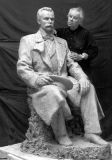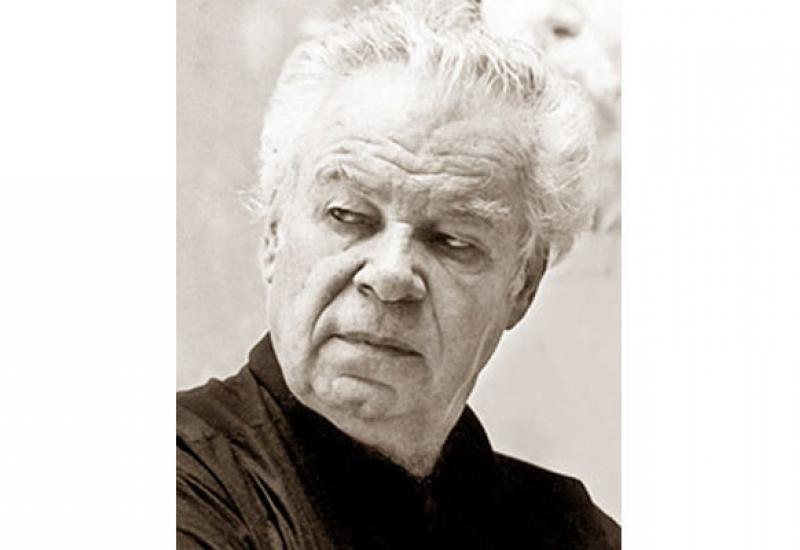O. P. Skoblikov was one of the masters whose works added to the memory of eminent creators who had greatly contributed to science, education and culture of Ukraine. His creativity boosted authorities of National Technical University of Ukraine “Kyiv Polytechnic Institute”, who intended to monumentalize images of outstanding scholars with the help of art.
Olexandr Pavlovych started with sculpturing busts of famous Ukrainian scientists to decorate State Polytechnic Museum lobby. The busts, which had been installed there, immediately draw the visitors in the solemn atmosphere of art and science. Made in classical way, but with the peculiar expression typical of O. P. Skoblikov, the busts remind of a significant contribution outstanding Ukrainian scientists made to different realms of science and technospheres: M. M. Bogolubov – to mathematics, S. P. Korolyov – to space engineering; I. P. Bardin – to metallurgy; E. O. Paton – to bridge construction and electric welding; S. O. Lebedev – to welding process and electronic computing machines, etc.
In 2001 the Academic board of National Technical University of Ukraine “Kyiv Polytechnic Institute” made a decision to install the E. O. Paton memorial in the university premises in honour of an ex-professor of the KPI, a founder and a head of bridge department and welding industry department, a dean of engineering division, and a worldwide famous welding technology scholar.
Not everyone knows that in the early XX century Evgen Oskarovych Paton also founded the KPI Engineering Museum, now known as State Polytechnic Museum of Ukraine. The memorial was decided to be installed right opposite to it, in a small garden with a fountain.
 O. P. Skoblikov’s sculpture “Evgen Oskarovych Paton” was mostly done in the middle of February 2002 and had to be shown to his son, Borys Evgenovych Paton, a president of National Academy of Sciences and, incidentally, a KPI graduate (1941). It was required to “get the nod” of Borys Evgenovych Paton, take into account his wishes and remarks, and then the sculpture could be cast.
O. P. Skoblikov’s sculpture “Evgen Oskarovych Paton” was mostly done in the middle of February 2002 and had to be shown to his son, Borys Evgenovych Paton, a president of National Academy of Sciences and, incidentally, a KPI graduate (1941). It was required to “get the nod” of Borys Evgenovych Paton, take into account his wishes and remarks, and then the sculpture could be cast.
We were lucky to observe the Master’s creative process.
At first master’s studio greeted the representatives of the KPI, who were me and S. K. Tymchenko, and then, a bit later, V. M. Bernadsky, an honoured worker of science and technology of Ukraine, and academician B. E. Paton arrived.
I have to admit, we were surprised at the workrooms pass system as well as the very surroundings which were as if of a manufactory, or a plant, or some kind of production. All around there were piles of dust, some baffles, the corners were sinking in dark shadows. All of a sudden we ended up in a spacious hall – sculptor’s studio, full of numerous statues. Among them there were many busts of famous people from Stalin’s, Brezhnev’s times as well as from present days. My attention was caught by a very interesting bust of Borys Evgenovych Paton, which had been installed in Kyiv near the Zoological Museum. It seemed that there was its copy in the studio. To my mind, this work was of a high artistic merit; it subtly reflected mood and a smile of a gentle-hearted person and a prominent scholar. I was happy to stand in the studio, where this sculpture had been created, along with the author of this masterpiece.
Yet we were fascinated even more once we saw a sculptural image of a sitting man in his forties, looking very familiar. It was clear to be the very sculpture of E. O. Paton, made of sole-coloured material, possibly clay or plasticine. Together with the sculptor, we got to look over his works, standing on four- or five-stage stands, when Borys Evgenovych entered the room, greeted everyone in a friendly manner, and the unusual work began.
Borys Evgenovych approached his father’s statue and said: “It seems to me… something is a bit wrong… I can’t get the hang of…”
It took half an hour hovering around the sculpture to “get the hang of” what was actually “a bit wrong”. V. M. Bernadsky, who prepared all the documental and illustrative material for the sculptor, took an active part in the discussion, too. At last, Borys Evgenovych said: “I think it is hair that is not okay. There is too much hair”.
Upon hearing that Olexandr Pavlovych said: “Let us conduct such an experiment”.
With those words he took his spatula, approached the sculpture and climbed up onto the platform, where the whole statue stood spinning. I thought with fear: “If he climbs up onto the platform, everything will fall down or something else will happen”. But, thanks God, nothing fell down, and sculptor started quickly and bravely “cutting off” excessive hair with his wooden spatula. I felt myself uneasy, though; until that moment there was a decent and finished image standing in front of us, it was sincere, pleasant, and gentle, and the very next second it began being torn, cut, changed. We all were looking cautiously; what was going to happen next?
Next, the sculptor cut off hair from another side of the head. Everything was changing right before our eyes, but we couldn’t understand if it was for the better or for the worse. At the very intense moment we heard the Borys Evgenovych’s voice: “That’s right, he did have a little hair… I had cut it myself. I do know how much he had”. And he asked Olexandr Pavlovych to cut off more and more. When the bush of hair became smaller, the image, according to the words of Borys Evgenovych, started to “resemble itself”.
The same thing concerned eyes. Borys Evgenovych was observing them very closely and mumbling something out loud, when the sculptor spoke: “To get the eyes expression, you need to imagine that the sculpture would be standing one meter higher than you. And if you look bottom-upwards, eyes of the model will open up”.
Stanyslav Tymchenko sat down and said: “This angle surely changes everything”. Borys Evgenovych heard that and crouched, too. There was a light laughter, and Borys Evgenovych admitted: “Sure, the perception has changed along with the angle”. I stumbled upon an idea to find a back-stool and offered a seat to Borys Evgenovych. He sat down, and the work went on. In some time Borys Evgenovych exclaimed something loudly, as if he made a discovery for himself, and then he asked, intentionally drawling: “May I ask a silly question?”
His exclamation brought to a second standstill every discussion and conversation, and in the moment of silence everyone echoed: “Sure, sure, you may”.
“Look,” said Borys Evgenovych. “In the photo he has a stand-up collar and a triangle-folded shirt. A tie goes with it. And what is it that you have?” he asked the sculptor. “Here is a triangle, but the tie is replaced by something like a bow! And this bow is bending somewhere sidewards…”
Everyone looked at the photo, then at the sculpture and saw a neckerchief, stretching to the right and to the left. It seemed like the sculptor wanted to make something of his own, decorative. He listened to everything, nodded consentingly and said: “Why, give me a moment”. He promptly removed this decoration, and it got better straight away. Someone noticed that the tie in the photo was elongated and well-shown. Others added that in the photo Evgen Oskarovych was wearing aт overcoat with a big collar, which had been popular earlier with cadets; except for the labels which were technical. And right in front of us the sculptor took some plasticine off the “neckerchief” and added to the tie, so that it became seemingly longer and more visible.
All that being done, someone shouted: “Here it is, an image of a teacher, scholar!”
Borys Evgenovych turned on his stool and firmly replied: “Yes, it is!”
This is how the artistic image was made.
All in attendance became convinced that it was a Master standing in front of them, the Master, who could promptly react to suggestions, transform and change image. All also became convinced that this was a remarkably difficult creative process.
The memorial appeared to be interesting and resembling and fitted well into architectural and natural surroundings of the KPI. It laid the foundation of a sculptural gallery featuring eminent scientists, constructors and engineers of the KPI. Unveiling of the memorial took place on 21th June 2002 and was an outstanding historical and artistic event in Kyiv.
Later Olexandr Pavlovych created a memorial in honour of academician S. O. Lebedev, an inventor of the first electronic computing machine in continental Europe (unveiled in November 2002), and M. P. Kravchuk, a prominent Ukrainian mathematician of XX century (unveiled in May 2003).
The emphasis should be laid on the fact that mentioned sculptural works were pioneers; these eminent scientists and engineers were monumentalized in memorials for the first time.
O. P. Skoblikov also made a bass-relief which adorns the first university building. On the bass-relief there is a famous Russian scholar D. I. Mendeleev, who was the first head of the State examination committee on the first KPI engineers graduation.
Olexandr Pavlovych co-worked with his colleagues from the KPI. So, casting of mentioned Skoblikov’s bronze sculptures took place on the educational basis at the foundry department (V. G. Mogylatenko as a head of the department). Moulder Y. D. Lytvynenko, minter V. I. Cheremnyh, associate professor E. O. Platonov and students took part in process of creating memorials.
I happened to meet Olexandr Pavlovych and observe different projects and conceptions being turned into reality for many times. Every meeting proved him to be an interesting and open-minded person and a prominent Ukrainian sculptor.
Yet the most unforgettable meeting with the Master was the one in his studio, which I described above.

